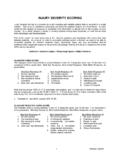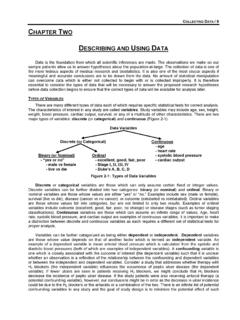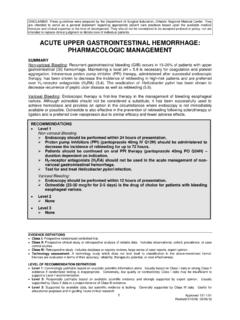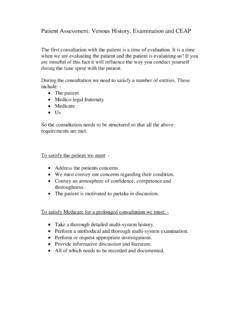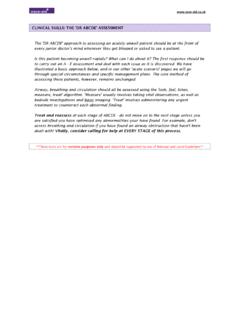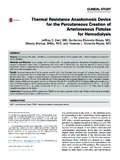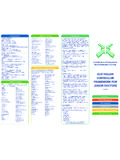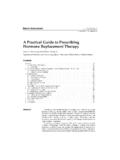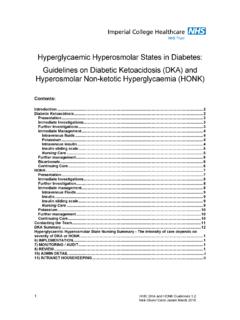Transcription of FEVER ASSESSMENT - SurgicalCriticalCare.net
1 DISCLAIMER: These guidelines were prepared by the Department of Surgical Education, Orlando Regional Medical Center. They are intended to serve as a general statement regarding appropriate patient care practices based upon the available medical literature and clinical expertise at the time of development. They should not be considered to be accepted protocol or policy, nor are intended to replace clinical judgment or dictate care of individual patients . EVIDENCE DEFINITIONS Class I: Prospective randomized controlled trial. Class II: Prospective clinical study or retrospective analysis of reliable data. Includes observational, cohort, prevalence, or case control studies. Class III: Retrospective study. Includes database or registry reviews, large series of case reports, expert opinion. Technology ASSESSMENT : A technology study which does not lend itself to classification in the above-mentioned format.
2 Devices are evaluated in terms of their accuracy, reliability, therapeutic potential, or cost effectiveness. LEVEL OF RECOMMENDATION DEFINITIONS Level 1: Convincingly justifiable based on available scientific information alone. Usually based on Class I data or strong Class II evidence if randomized testing is inappropriate. Conversely, low quality or contradictory Class I data may be insufficient to support a Level I recommendation. Level 2: Reasonably justifiable based on available scientific evidence and strongly supported by expert opinion. Usually supported by Class II data or a preponderance of Class III evidence. Level 3: Supported by available data, but scientific evidence is lacking. Generally supported by Class III data. Useful for educational purposes and in guiding future clinical research.
3 1 Approved 04/30/01 Revised 10/08/07, 01/30/2013 FEVER ASSESSMENT SUMMARY The onset of FEVER in the intensive care unit patient must be approached systematically and guided by clinical findings. Current literature emphasizes utilizing a cost-conscious approach, minimizing the use of low yield tests that have little impact on clinical outcome and may be detrimental to the patient. RECOMMENDATIONS Level 1 If catheter-related sepsis is suspected, two peripheral blood cultures should be obtained with an additional culture from each indwelling catheter. If a lower respiratory tract infection is suspected, obtain a portable AP chest radiograph. Gram stains of centrifuged urine should be used to select antimicrobial therapy. Level 2 Core body temperature measurements from an intravascular or urinary catheter or esophageal thermistor should be used when available.
4 If clinical evaluation does not strongly suggest a non-infectious cause, blood cultures should be obtained within the first 24 hours of FEVER . Expressed purulence from an intravascular catheter insertion site should be cultured. Use quantitative catheter cultures to determine the source of bacteremia/fungemia. Do not routinely culture removed intravascular catheters. Culture only those suspected of being the source of infection. Quantitative cultures obtained by either bronchoscopy or catheter lavage should be obtained if pneumonia is suspected. Pleural fluid should be cultured if an adjacent infiltrate is noted or infection is suspected. Evaluation for C. difficile infection should begin with a C. difficile toxin EIA. Send stool cultures for enteric pathogens or ova and parasite only if diarrhea was present prior to ICU admission, the patient is immunocompromised or it is epidemiologically indicated.
5 Obtain urine for microscopic exam, Gram stain and culture in all high risk patients showing signs or symptoms of UTI. Surgical wounds with suspected infection should be opened to obtain samples for Gram stain and culture. Cultures of the skin overlying a wound should not be performed. If there is sufficient clinical suspicion, a CT scan of the sinuses should be obtained. If CNS infection is suspected, send CSF for Gram stain and culture, glucose, protein, and cell count with differential. Level 3 Chest radiographs, urinalysis, or urine cultures are not indicated in the first 72 hours post-operatively unless history and clinical findings suggest a high probability of infection. Noninfectious causes of FEVER should be investigated, including new medications and administration of blood products. If FEVER is accompanied by altered consciousness or focal neurologic deficits, lumbar puncture or evaluation of CSF from an indwelling ventriculostomy should be considered.
6 2 Approved 04/30/01 Revised 10/08/07, 01/30/2013 INTRODUCTION FEVER is defined as an elevation in core body temperature greater than C (101 F) and is one of the most frequently detected abnormal signs in the intensive care unit (ICU) patient population. This physiological response is known to have direct antimicrobial effects, in addition to its role in augmenting humoral and cellular defense mechanisms. Although in some instances FEVER is indicative of an adequate systemic response, acute onset of FEVER has been associated with ICU mortality in 12% of cases [1]. Appropriate evaluation of FEVER , and institution of early, goal directed therapy when indicated, is associated with a clear survival benefit for patients who are septic, experiencing endocrine emergencies, and those with other causes of temperature dysregulation. FEVER evaluations in the ICU setting should be guided by clinical ASSESSMENT instead of automatic laboratory and radiologic tests.
7 LITERATURE REVIEW In 2008, the Society of Critical Care Medicine (SCCM) and the Infectious Diseases Society of America convened a task force to update the 1998 practice parameters for the ASSESSMENT of FEVER in ICU patients . The 2008 guidelines presented numerous recommendations based on discussion of the published literature and panel members expertise [2]. The Cochrane Library and the National Clearing House databases were used to identify trials, meta-analyses, literature reviews and most recent clinical recommendations pertaining to the evaluation of the acute onset of FEVER in the ICU population. Finally, a review of literature published in critical care medicine journals within the last 4 years was conducted and considered in this review. Measuring Temperature The first step in evaluating FEVER is to accurately assess temperature.
8 Although the gold standard for temperature ASSESSMENT is core temperature obtained in the central circulation, its use is not always indicated in ICU patients . Bladder catheters with thermistors, although costly, have been shown to provide essentially identical readings to thermistors in intravascular sites, are less invasive and provide stable measurements, regardless of urine flow rate [2]. In spite of the fact that esophageal probes have demonstrated temperature monitoring accuracy comparable to that of central venous and bladder catheter thermistors, they are not commonly utilized in the ICU. Less invasive modes of monitoring core body temperature incorporate the use of infrared thermometry to record temporal artery and tympanic membrane temperatures. Although initially the temporal artery thermometer was considered to be as accurate and precise as invasive core temperature measurements, observational studies have demonstrated a mean difference of C when compared to bladder catheter temperatures.
9 Due to the lack of consensus with other established modes of core body temperature monitoring, the use of temporal artery thermometry is not recommended in situations where accurate and precise body temperature monitoring is indicated (Level 2) [3]. Infrared ear thermometry has been shown to yield inaccurate readings in the setting of inflammation of the auditory canal or tympanic membrane as well as poor correlation with core temperature readings. A study among 110 ICU patients comparing central venous, axillary, tympanic membrane, and urinary bladder thermistors found that tympanic membrane measurements showed only modest correlation with central venous (r= ), urinary (r= ), and axillary (r= ) temperatures. The average difference between central venous and urinary temperature was small at , with a statistically significant correlation (p= ).
10 This paper adds to a growing body of evidence that questions tympanic membrane measurements and suggests that urinary bladder temperature monitoring is the preferred alternative when central venous monitoring is not indicated and Foley catheter placement is indicated (Level 2) [4]. Evaluation of the Patient With new onset of FEVER , a thorough search for possible etiologies should be performed. It is important, however, to maintain a lower temperature threshold among the immunocompromised population. It should also be considered that infections may be concealed by euthermia or hypothermia in certain patient populations, such as the elderly, those with open abdominal wounds, extensive burns, and those receiving extracorporeal membrane oxygenation or continuous renal replacement therapy [2]. Regardless 3 Approved 04/30/01 Revised 10/08/07, 01/30/2013 of the patient s status it is important to conduct both a careful physical examination and thorough review of the patient s medical record.
